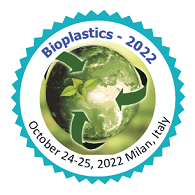Renowned Speakers

Dr. Rodrigo Andler
Catholic University of Maule Chile

Anastasiya Svirepa
Kurt-Schwabe-Institut für Mess- und Sensortechnik Meinsberg Germany

Jianhua He
Researcher | Hunan Agricultural University China

Ranganath Shastri
Expert Plastics Solutions Mexico

Atul Bali
Competitive Green Technologies Canada

Dr. Frank Ehrig
Institute for Material Science and Plastics Processing Switzerland

Cengiz Altan
University of Oklahoma USA
Recommended Global Biotechnology Webinars & Conferences
Asia Pacific & Middle East
Canada
Bioplastics-2022
About Conference
Conference Series Ltd is overwhelmed to announce the commencement of 17th International Conference on Bioplastics & Biopolymers to be held during October 24-25, 2022 Milan, Italy. The upcoming conference will be organized around the theme "Recent advances and future trends in Biopolymers and Bioplastics".
Conference Series Ltd organizes 1000+ Conferences every year across USA, Europe & Asia with support from 1000 more scientific Societies and Publishes 700+ Open Access Journals which contains over 50000 eminent personalities, reputed scientists as editorial board members.
The Bioplastics-2022 theme has broad interests, which address many aspects of Bioplastics, plastic materials, Bioplastics and Biopolymers. Depending on the nature of the repeating unit they are made of polysaccharides, proteins of amino acids, and nucleic acids of nucleotides. The studies are more concerned to Green Composites, Biopolymer Feed Stock Challenges, Biofibers & Microbial Cellulose, Biomaterials and Bioplastics. Advanced studies are being made to improvise developments in Biopolymer Technology, Waste Management, pharmaceutical and biomedical applications, Biodegrade ability, and many more.
Conference Highlights:
- Bioplastics
- Biopolymers & Bioplastics
- Future and Scope for Biopolymers And Bioplastics
- Biopolymer Applications
- Biocomposite Materials
- Nano Polymers
- Biodegradable Polymers
- Biobased Thermosetting Polymers
- New-To-The-World Biopolyesters
- Production and Commercialization
- Routes To Drop-In Monomers and Bioplastics
- Ocean plastics
- Bioplastics Applications
- Polymers and Nanotechnology
- Synthesis and Characterization of Biopolymers
- Applications of Polymers
Why to attend?
With members from around the world targeted on learning concerning Bioplastics and its advances; this is frequently your stylish chance to succeed in the most important assemblage of actors from the Bio plastics and Biopolymers community. Conduct shows, distribute word, meet with current and implicit scientists, produce a splash with new discoveries within the advanced Molecular ways, and admit name recognition at this 2- day event. World-famed speakers, the foremost recent ways, developments, and also the newest updates in Experimental Bioplastics, biopolymers, organic chemistry, Waste management, cell biology, and natural wisdom are emblems of this conference.
The Bioplastics conference aims to develop an integrated underneath standing of how shops will grow under extreme environmental conditions as plastics. The conference addresses the introductory biology of shops at the molecular and physiological position, also as their relations with different organisms and adaption to unfavourable environmental conditions. Integrating this understanding in an exceedingly larger systems idea can modify up factory forbearance to abiotic and biotic factors and grease reinstate sustainable husbandry in thirsty regions of the globe.
Scope & Benefits
Conference Series llc Ltd is pleased to invite you to participate in the 17th International Conference on Bioplastics & Biopolymers to be held during October 24-25, 2022 Milan, Italy (Hybrid).
The 17th International Conference on Bioplastics & Biopolymers aims to bring together experts from various disciplines of waste management, education, research and management and provides an ambient platform for practitioners, researchers and students to sow and gather knowledge on recent and current advancements in the various fields of Bioplastics. Bio scientists and allied healthcare professionals will have ample opportunity to connect with colleagues, researchers, exhibitors and young talent and have discussions on emerging trends and challenges in practice in the future.
Benefits:
- Accepted abstracts will be published in Journal of Orthodontics and Endodontics provided with DOI
- Networking Opportunities, Grow Your Professional Network
- Build Your Knowledge Base
- Expand Your Resources
- Break Out of Your Comfort Zone
- New Tips & Tactics
- Greater Focus
- The Serendipity of the Random Workshop
Sessions and Tracks
1: Bioplastics
Bioplastic is a biodegradable material that come from renewable sources and can be used to reduce the problem of plastic waste that's suffocating the earth and contaminating the terrain. Plastic is the third most generally used petroleum outgrowth in the world; each time 200 million tons of plastic are consumed on the earth. It comes from a non-renewable source (petroleum), it's polluting and non-biodegradable (it can take further than 1000 times to putrefy). Bioplastics are moreover made from a renewable resource similar as sludge or sugar club (biobased), break down fully via a natural process( biodegradable) are both biobased and biodegradable.
2: Biopolymers & Bioplastics
Biopolymers are the wide nobility of accoutrements that encompass bioplastics, but that also includes natural polymers similar as silk, chitosan and hair. Other exemplifications of biopolymers correspond of natural rubbers (polymers of isoprene), suberin lignin (complex polyphenolic polymers), cutin and cutan (complicated polymers of long- chain adipose acids) and melanin. Basically, bioplastics arebio-primarily grounded, biodegradable, or both. The time period 'bio-primarily grounded' means that the cloth or product is at least incompletely deduced from biomass (factory life) exemplifications of biomass used in bioplastics include sludge, sugarcane, tapioca, or other types of cellulose. Some bioplastics are entered through processing at formerly from natural biopolymers along with polysaccharides. Starch, cellulose, chitosan and alginate) and proteins (e.g. Soy protein, gluten and gelatin), whilst others are chemically synthesised from sugar derivations (e.g. Lactic acid) and lipids (canvases and fats)
3: Future And Scope For Biopolymers And Bioplastics
The bioplastics assiduity is growing exponentially. In fact, its product capacity is anticipated to increase by 15% by 2024. Since July 1, 2021, numerous single- use plastic products have been banned in the EU to help combat plastic waste in the ocean unborn compass for Biopolymer and Bioplastics it's fastening on recent advances and unborn trends in biopolymers' to enhance and explore knowledge among biopolymers and bioplastics and to establish pots and swapping ideas. The environmental movement provided further development in bioplastics, numerous developments do including Ikea starting artificial product of bioplastics cabinet work.
4: Biopolymer Applications
Many biopolymers may be used for regenerative medicine, tissue engineering, drug shipping, and usual scientific applications because of their mechanical properties. Some of the not unusual place biopolymers and their applications: Collagen- One of the maximum ample biopolymers due to the fact it's miles the number one shape of the vertebrates. Because of its mechanical shape, excessive tensile strength and non-poisonous properties, it's miles broadly utilized in scientific sciences. Cellulose- It is a cheaper biopolymer and hence broadly used for its balance and strength. It is used as nano cellulose because of its ample deliver and biodegradable properties. Chitosan- It is used as a water cleanser and is a distinctly degradable material. With its antimicrobial properties, it's miles used to forestall developing microorganisms and is likewise used as a drug shipping to enhance absorption.
Biocomposite is a cloth composed of or greater awesome constituent substances (one being obviously derived) which are blended to yield a brand new cloth with advanced overall performance over person constituent substances. Biocomposite plastics constitute an appealing alternative, each of their bodily residences and their chemical makeup, to conventional petroleum primarily based totally plastic feedstock. The matrix section is shaped through polymers derived from renewable and nonrenewable resources. The matrix is essential to guard the fibers from environmental degradation and mechanical damage, to keep the fibers collectively and to transfer the hundreds on it Bio composites include or greater exceptional levels of substances wherein one section is a non-stop section known as matrix (both biopolymer, metallic and alloy, or bioceramic) while the opposite is the discontinuous section. It is the incorporation of fillers in a biocompatible matrix cloth.
A polymer or copolymer fabric containing scattered nanoparticles is Nano polymer. These Nano polymers may be linear or branched. The benefits of nano composite programs are-lighter and biodegradable, improved thermal stability, conductivity, mechanical electricity and fuel line barrier. Nano polymers, not like maximum composites, cannot dissociate in answers and includes amino companies as spine substances which itself, may also includes all composition of carbon, oxygen and nitrogen atoms, relying at the chemical nature of monomers hired for polymer synthesis the benefits of nano composite programs are-lighter and biodegradable, improved thermal stability, conductivity, mechanical electricity and fueloline barrier properties. Due to the extraordinarily small size, excessive volume-floor region ratio, tunable pore, polymer nanoparticles were used for numerous programs in extraordinary fields, for example, in drug delivery, biosensors, stimuli responsive shipment delivery, nano composites, agricultural and environmental programs.
7: Biodegradable Polymers
Biodegradable plastics and polymers have been first delivered in 1980s. The biodegradable polymers may be labeled consistent with their chemical composition, beginning and synthesis method, processing method, financial importance. Biodegradable polymers are a particular kind of polymer that breaks down after its supposed reason to bring about herbal byproducts together with gases (CO2, N2), water, biomass. Biodegradable polymers were used for greater than 50 years with various programs together with surgical sutures, wound dressings, tissue regeneration, enzyme immobilization, managed drug shipping and gene shipping, tissue engineering scaffold, cryopreservation, nanotechnology, medical implants and devices, In addition to medicine, biodegradable polymers are frequently used to lessen the extent of waste in packaging . There is likewise significant attempt to update substances derived from petrochemicals with those who may be crafted from biodegradable components.
8: Biobased Thermosetting Polymers
In substances science, a thermosetting polymer, regularly known as a thermoset, is a polymer this is acquired via way of means of irreversibly hardening ("curing") a gentle strong or viscous liquid prepolymer (resin). Curing is caused via way of means of warmth or appropriate radiation and can be promoted via way of means of excessive pressure, or blending with a catalyst. Thermosetting polymers are the cross-related polymers and closely branched chains. Thermosetting plastics on heating undergo widespread cross-hyperlinks in molds and yet again come to be infusible. Thermosetting plastic can resist excessive temperatures and as soon as hardened those cannot be reformed or recycled inspite of the software of warmth. The use of thermoset plastics has some of advantages. Unlike thermoplastics, they maintain their power and form even if heated. This make thermosetting plastics well-proper to the manufacturing of everlasting additives and large, strong shapes.
9: New-To-The-World Biopolyesters
Biopolyester is a microbial polyester biosynthesized from sugar and plant oil with the aid of using microorganism. This biopolyester has the biodegradability in surroundings They are produced while micro organism are uncovered to carbon reassets whilst all different vital vitamins come to be limited. PHB is a biodegradable polyester synthesized with the aid of using biotechnological approaches. Biobased polyesters are a huge magnificence of bioplastics which might be derived from renewable sources consisting of herbal fat and oils. Some biobased polyesters which have won business use or which might be currently Investigated for business use encompass polylactic acid (PLA), polyglycolic acid (PGA), poly-ε-caprolactone (PCL), polyhydroxybutyrate (PHB), and polyhydroxyalkanoate (PHA). Among these, PLA is the maximum drastically studied biodegradable thermoplastic polyesters. It is definitely biodegradable and biocompatible polyester with a especially excessive melting point (160 °C).
10: Production And Commercialization
Bioplastics are made through converting the sugar found in flowers into plastic. Bioplastic production makes use of renewable biomass reassets inclusive of plant-based feedstocks along with corn, rice, palm fiber, potatoes, wooden cellulose. The bioplastic manufacturing procedure is easy venture which could effortlessly be taken up as a DIY hobby at home. With easy uncooked substances like starches, gelatins, agar, vinegar, etc, a sheet or a mould of bioplastics may be prepared. Some bioplastics are derived from corn starch, cellulose esters and cellulose derivatives, protein reassets inclusive of wheat gluten.
Commercial Uses of Bioplastics:
- Packaging and Bags
- Houseware and Kitchenware
- Medical Equipment
- Electronics
- Automobile industry
11: Routes To Drop-In Monomers And Bioplastics
Plastics are made from many identical small particles called monomers. These monomers are strung together like a chain to form a polymer. Combination of monomers forms the polymers in plastic. Bio-based drop-in chemicals are bio-based versions of existing petrochemicals which have established markets. Bio-based drop-in chemicals usually differ from their petrochemical counterparts in price (mostly more expensive)and in environmental footprint (mostly lower).Regarding the ease of implementation, bio-based drop-in chemicals are easy to implement technically, as existing infrastructure can be used. However, due to their usually higher price compared to their fossil counterparts they are often not competitive. The drop-in bioplastics are more expensive than the original fossil based plastics, this may be due to Economy of scale, R&D and Price of raw material.
12: Ocean Plastics
Oceans are polluted through plastic debris ranging in length from huge unique cloth consisting of bottles and bags, right all the way down to microplastics formed from the fragmentation of plastic cloth. This cloth is simplest very slowly degraded or eliminated from the sea so plastic debris are now extensive during the floor ocean and are recognised to be having deleterious consequences on marine life. At least 14 million lots of plastic emerge as within the ocean each year from floor waters to surface of oceans. Thousands of seabirds and sea turtles, seals and different marine mammals are killed every yr after consuming plastic or getting entangled in it. When merchandise or substances are marine degradable, this indicates they may disintegrate (bodily smash down) into portions smaller than 2mm in simply three months, and can be absolutely biodegraded (chemically damaged right all the way down to harmless factors and compounds) in beneath 6 months. This makes those substances a great deal much less possibly to damage marine wildlife.
Bioplastics can greatly reduce our dependence on fossil resources – which are significantly more harmful to the environment than bioplastics. So, it’s no surprise that you can expect to see a surge in the production and use of bioplastics in the coming years.
Here's a list of applications and sectors where bioplastics, biobased plastic, biodegradable plastic, compostable plastics, biopolymers, biocomposites and biochemicals have been used in the following market segments:
- Packaging
- Food-services
- Agriculture & horticulture
- Consumer electronics
- Automotive & transport
- Consumer goods and household appliances
- Building & construction
- Coating & adhesives
14: Polymers And Nanotechnology
Nanotechnology is presently one of the fastest developing areas in science. The natural period scales of polymer chains and their morphologies within the bulk, which lie within the nanometer domain, make polymers perfect constructing blocks for nano technology. Polymer nano composites consist of a polymer or copolymer having Nano debris dispersed within the polymer matrix. The programs of nano technology, typically include commercial, medicinal, and energy uses. These consist of more durable construction materials, healing drug transport, and better density hydrogen gas cells which can be environmentally pleasant. Polymers play an crucial position, because they integrate a number of beneficial features, together with flexibility, processability, low value, size in the nanometerrange, numerous functionalities and microphase separation.
15: Synthesis And Characterization Of Biopolymers
Bioplastics synthesized from monomers with herbal source: Polylactic acid (PLA) is the primary member of this family. PLA is an fragrant polyester derived from monomers of lactic acid that is produced via way of means of the microbial fermentation of agriculture via way of means of-products, mainly carbohydrate-wealthy substances Characterization of biopolymers. The maximum broadly used characterization strategies of biopolymers encompass Fourier remodel infrared spectroscopy (FTIR), X-ray diffraction (XRD), thermogravimetric evaluation (TGA) and scanning electron microscopy (SEM). The primary characterization strategies of biopolymer membranes and movies is presented, focusing at the basics and strategies of evaluation of every approach implemented to biopolymers. In the physicochemical characterization section, microscopy strategies, Fourier remodel infrared spectroscopy, Raman spectroscopy, nuclear magnetic resonance spectroscopy, X-ray diffraction, X-ray photoelectron spectroscopy, and thermal evaluation are addressed. Then, bodily characterizations, including swelling, degradation/erosion degree, mechanical and barrier properties, touch angle, and textural evaluation implemented to biopolymer membranes and movies are elucidated. Finally, the primary organic characterizations are reported, including cytotoxicity, sensitization capacity, and inflammation potential.
16: Applications Of Polymers
Polymers are increasingly being used in a wide variety of applications in electronics and photonics, most of which use polymers in their traditional role as engineering materials. The application of polymers are divided into various types of fields: Agricultural field: Mulching films, green house films are the best examples for the polymer films. Biodegradable polymers are generally used for this purpose. Medical field: Syringes, capsules, medicine packaging, urine bags are the examples. Transport field: car bumpers, wheel covers etc are also made by the use of polymers. Electrical field: wire coating, switches etc. Household applications: Bowls, kitchen accessories are also made by the polymers. Speciality polymers like PEEK, PEK are used in aeroplanes
Market analysis
The plastics industry is changing. Forecasts are predicting bioplastics will see tremendous growth over the next decade and now is an ideal moment for investors to start looking at bioplastics manufacturers. Over the past few years, large plastic companies have become interested in having a more sustainable option to offer companies and consumers, similar to many other markets such as energy, agriculture and fuels. Bioplastics differ when compared to those other markets because the industry doesn’t rely on government subsidies. Instead, the responsibility is on the manufacturers to figure out how to reduce costs and make themselves a bigger player in the plastics market.
Biodegradable plastics, for example polylactic acids (PLA) and starch polymers, reached a market share of 65% of the total bioplastics market in 2020. For this product group, Ceresana expects further growth of 10.2% per year until 2030. For biobased plastics, such as polyethylene, PET or polyamide (PA), which are not biodegradable, growth is expected to be lower with 7.5% per year. Ceresana's latest market report analyzes how the use of bioplastics is developing in different sales markets. The most important sales market for bioplastics in 2020 was the packaging industry - more than 58% of all bioplastics were processed here.
To Collaborate Scientific Professionals around the World
Conference Date October 24-25, 2022
For Sponsors & Exhibitors
Speaker Opportunity
Useful Links
Supported By
All accepted abstracts will be published in respective Conference Series International Journals.
Abstracts will be provided with Digital Object Identifier by








